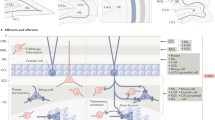Summary
Silver impregnation performed 1–2 days after transient forebrain ischemia in the Mongolian gerbil demonstrated terminal-like granular deposits in the outer two-thirds of the hippocampal dentate molecular layer (perforant path terminal zone), even though neither the cell bodies of origin of the perforant path nor the dentate granule cells were destroyed. Electron microscopic studies of the dentate gyrus were performed in an effort to discover the identity of these degenerating structures. Electron microscopy revealed that the granular silver deposits corresponded to electron-dense profiles. Many of these were degenerating boutons and some were degenerating postsynaptic dendritic fragments, but most of them could not be identified with certainty. Electron-dense profiles were less numerous than expected from the density of granular silver deposits. These structures were probably the degenerating axons, axon terminals and dendrites of CA4 neurons. The granular silver deposits and electron-dense boutons observed in the inner third of the dentate molecular layer 5 days after transient ischemia can probably be explained by the ischemia-induced degeneration of CA4 mossy cells, which give rise to the dentate associational-commissural projection. Finally, most mossy fiber boutons in area CA4 and some boutons in the molecular layer appeared watery and enlarged on postischemia days 1 and 2. Mossy fiber boutons with this ultrastructural appearance have previously been observed in seizure-prone animals and in animals undergoing convulsant-induced seizures. Although no postischemic seizures occur under the conditions of this study, these findings support the idea that excitatory pathways become hyperactive after transient ischemia.
Similar content being viewed by others
References
Amaral DG (1978) A Golgi study of cell types in the hilar region of the hippocampus in the rat. J Comp Neurol 182:851–914
Armstrong DR, Neill KH, Crain BJ, Nadler JV (1989) Absence of electrographic seizures after transient forebrain ischemia in the Mongolian gerbil. Brain Res 476:174–178
Bakst I, Avendaño C., Morrison JH, Amaral DG (1986) An experimental analysis of the origins of somatostatin-like immunoreactivity in the dentate gyrus of the rat. J Neurosci 6:1452–1462
Crain BJ, Evenson DA, Polsky K, Armstrong DR, Nadler JV (1987) Electron microscopic study of the gerbil dentate gyrus after transient forebrain ischemia. Soc Neurosci Abstr 13:1498
Crain BJ, Westerkam WD, Harrison AH, Nadler JV (1988) Selective neuronal death after transient forebrain ischemia in the Mongolian gerbil: a silver impregnation study. Neuroscience 27:387–402
Fifková E (1975) Two types of terminal degeneration in the molecular layer of the dentate fascia following lesions of the entorhinal cortex. Brain Res 96:169–175
Gottlieb DI, Cowan WM (1973) Autoradiographic studies of the commissural and ipsilateral association connections of the hippocampus and dentate gyrus of the rat. J Comp Neurol 149:393–422
Johansen FF, Zimmer J, Diemer NH (1987) Early loss of somatostatin neurons in dentate hilus after cerebral ischemia in the rat precedes CA-1 pyramidal cell loss. Acta Neuropathol (Berl) 73:110–114
Kaplan TM, Lasner TM, Nadler JV, Crain BJ (1989) Lesions of excitatory pathways reduce hippocampal cell death after transient forebrain ischemia in the gerbil. Acta Neuropathol 78:283–290
Kirino T (1982) Delayed neuronal death in the gerbil hippocampus following ischemia. Brain Res 239:57–69
Kirino T, Sano K (1980) Changes in the contralateral dentate gyrus in Mongolian gerbils subjected to unilateral cerebral ischemia. Acta Neuropathol (Berl) 50:121–129
Lee K, Stanford E, Cotman C, Lynch G (1977) Ultrastructural evidence for bouton proliferation in the partially deafferented dentate gyrus of the adult rat. Exp Brain Res 29:475–485
Matthews DA, Cotman C, Lynch G (1976) An electron microscopic study of lesion-induced synaptogenesis in the dentate gyrus of the adult rat. I. Magnitude and time course of degeneration. Brain Res 115:1–21
McWilliams R, Lynch G (1978) Terminal proliferation and synaptogenesis following partial deafferentation: the reinnervation of the inner molecular layer of the dentate gyrus following removal of its commissural afferents. J Comp Neurol 180:581–616
McWilliams R, Lynch G (1979) Terminal proliferation in the partially deafferented dentate gyrus: time courses for the appearance and removal of degeneration and the replacement of lost terminals. J Comp Neurol 187:191–198
Nadler JV, Perry BW, Gentry C, Cotman CW (1980) Loss and reacquisition of hippocampal synapses after selective destruction of CA3–CA4 afferents with kainic acid. Brain Res 191:387–403
Nadler JV, Perry PW, Gentry C, Cotman CW (1981) Fate of the hippocampal mossy fiber projection after destruction of its postsynaptic targets with intraventricular kainic acid. J Comp Neurol 196:549–569
Nitsch C, Rinne U (1981) Large dense-core vesicle exocytosis and membrane recycling in the mossy fibre synapses of the rabbit hippocampus during epileptiform seizures. J Neurocytol 10:201–219
Peterson GM, Ribak CE, Oertel WH (1985) A regional increase in the number of hippocampal GABAergic neurons and terminals in the seizure-sensitive gerbil. Brain Res 340:384–389
Ribak CE, Seress L, Amaral DG (1985) The development, ultrastructure and synaptic connections of the mossy cells of the dentate gyrus. J Neurocytol 14:835–857
Steward O (1976) Topographic organization of the projections from the entorhinal area to the hippocampal formation of the rat. J Comp Neurol 167:285–314
Steward O, Vinsant SL (1983) The process of reinnervation in the dentate gyrus of the adult rat: a quantitative electron microscopic analysis of terminal proliferation and reactive synaptogenesis. J Comp Neurol 214:370–386
Suzuki R, Yamaguchi T, Li C-L, Klatzo I (1983) The effects of 5-minute ischemia in Mongolian gerbils. 2.Changes of spontaneous neuronal activity in cerebral cortex and CA1 sector of hippocampus. Acta Neuropathol (Berl) 60:217–222
Swanson LW, Wyss JM, Cowan WM (1978) An autoradiographic study of the organization of intrahippocampal association pathways in the rat. J Comp Neurol 172:49–84
Vicedomini JP, Nadler JV. (1987) A model of status epilepticus based on electrical stimulation of hippocampal afferent pathways. Exp Neurol 96:681–691
Author information
Authors and Affiliations
Additional information
Supported by NIH Stroke Center grant NS 06233
Rights and permissions
About this article
Cite this article
Crain, B.J., Evenson, D.A., Polsky, K. et al. Electron microscopic study of the gerbil dentate gyrus after transient forebrain ischemia. Acta Neuropathol 79, 409–417 (1990). https://doi.org/10.1007/BF00308717
Received:
Revised:
Accepted:
Issue Date:
DOI: https://doi.org/10.1007/BF00308717




